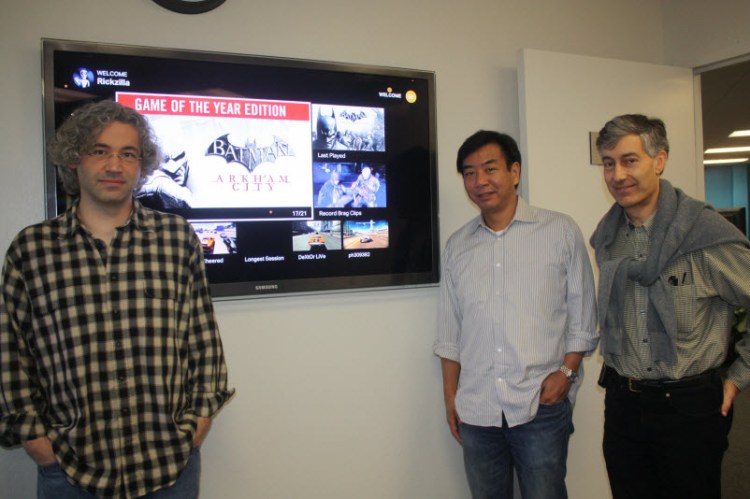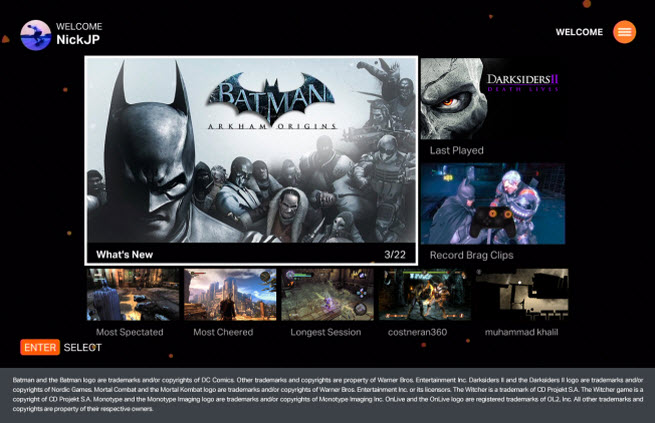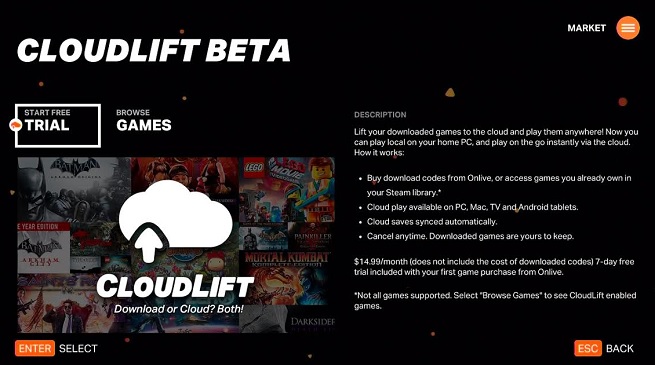OnLive has announced that former IGN chief Mark Jung is its new executive chairman, and today he is revealing a new direction for the company that starts with two new cloud-based gaming services.
The new services include CloudLift, a subscription service that lets users log in on any device to access their digital downloaded games from services such as Valve’s Steam service. It is also announcing OnLive Go, which lets users of online games such as War Thunder and Second Life play on mobile devices for the first time. In an interview, Jung said that OnLive’s strategy is more measured and complementary with the interests of game publishers and gamers.
“In this last year, we have been repositioning the company and redesigning our services for a positive business going forward,” Jung said. “We have rearchitected it to deliver a much higher value proposition for the users.”
OnLive is now aimed at extending and complementing local processing of games, rather than replacing the local use of an application.
In the past, OnLive sometimes clashed with its constituencies, and overcoming that reputation will make the reboot a bit of a challenge. The company, now based in Mountain View, Calif., started out with an ambitious and disruptive strategy. It pioneered the idea of cloud gaming, or using web-connected data centers to deliver high-end video games to just about any device. OnLive was the brainchild of Silicon Valley wunderkind Steve Perlman, creator of WebTV, Moxi, Rearden, and Artemis Networks.
But even as it tried to build a worldwide cloud gaming network, OnLive clashed with publishers like Electronic Arts and didn’t deliver as robust a network as it promised. It ran through more than $200 million in funding and finally ran out of money in mid-2012. Perlman lost control of the company, and investor Gary Lauder acquired the firm in an effort to salvage the business. Lauder recruited Jung and other new executives to help turn around the company and restore its reputation.
The new OnLive
Now, after about 20 months of work, they’re ready to unveil the new services and strategy. I got a good look at the services this week and spent time interviewing Jung, Lauder, and Rick Sanchez, the new vice president of product and marketing at OnLive.
CloudLift takes heavy-duty PC games and makes them playable on just about any device. It extends the experience to devices such as low-end laptops, tablets, Macs, and smart TVs. It costs $14.99 a month as a subscription service. But it doesn’t force gamers to buy a game more than once. It can, for instance, work with games that are purchased on Valve’s Steam digital distribution service in addition to games purchased on OnLive. In the past, a gamer had to separately buy a game on OnLive, even if they already had purchased it on a PC, in order to use it on the OnLive service.
“We got rid of that choice where gamers had to own it locally or play it in the cloud,” Sanchez said. “Now they can do both.”
That service delivers 720p quality video games running at 60 frames per second. It delivers them to devices by streaming video of game imagery from a data center to the device. Because the processing takes place in the cloud, which is now enhanced with heavy-duty graphics processors that don’t cost as much as they once did under the old regime, the games can be displayed on low-end devices which merely have to play them as videos.
The idea of CloudLift, like the old OnLive service, is to give PC gamers more freedom to play their games where it is most convenient.
OnLive Go, meanwhile, makes huge downloadable games, such as massively multiplayer games like War Thunder, more accessible. Instead of having to wait for hours before playing, OnLive Go allows players to instantly launch a cloud version of the game while it downloads in the background. It also allows players to play MMOs and virtual worlds on mobile devices.
“To implement these services, we had to do things behind the scenes to address scalability of our service, cost of our service, and its portability,” Jung said. “We had to address keeping the hardware up to date with modern technology.”
Revamped infrastructure
OnLive has opened new data centers in Chicago and Seattle, and it has expanded its existing data centers in Virginia, the San Francisco Bay Area, Dallas, and Luxembourg. And OnLive’s user interface is now built with HTML5, the lingua franca for the web, so that it can be updated much more easily across platforms.
OnLive still requires a relatively fast connection of 2 megabits a second and it works best with 5 megabits a second. That means you can access OnLive via Wi-Fi, cable modems, fiber, and DSL lines. But 4G wireless devices generally won’t work well. OnLive adapts the quality of what you see based on the moment-by-moment performance of your Internet connection.
OnLive still offers its PlayPack subscription service, which has 250 games available for $9.99 a month. CloudLift links the player’s own PC game library with his or her account and syncs the saved games to the cloud. Players can access those saved games from multiple devices, allowing them to pick up a game they were playing on a PC and then start playing it on a tablet. They can access the full game experience, not just a dumbed-down version, on portable gear.
OnLive will also sell download codes. If you purchase a download code for game from OnLive, it will include a 7-day free trial of CloudLift, which makes OnLive the only digital download retailer that offers cloud play as an added benefit to a game purchase.
In the past, OnLive targeted gamers in homes who were playing games on their PCs. But those gamers often already had the games playable on Steam or on disks. They didn’t need OnLive in the home. That also encouraged the costly, bandwidth-intensive behavior where gamers played cloud games for hours at a time. That consumed a lot of processing power and bandwidth, adding to OnLive’s costs.
With CloudLift, the usage pattern should be different. People on the run may play games for a shorter time. They will still get the benefit of accessing their games from anywhere, but their usage is unlikely to drive OnLive’s costs through the roof, Jung said. That makes OnLive’s business model more efficient, since the company has a large capital outlay to make in running data centers. On top of that, the Internet is running faster for a lot more users. Akamai estimates that 34 percent of internet users in the U.S. have more than 10 megabits per second bandwidth.
“The faster it gets, the less a user cares about where the central processing unit (CPU) and graphics processing unit (GPU) are located,” Lauder said.
Jung said game publishers will like the CloudLift service because it widens usage of their games and expands their addressable market to people who would never otherwise buy a heavy-duty game, since their home machines can’t run it.
CloudLift is launching with 20 games, including Batman: Arkham Origins, The LEGO Movie Videogame, Saints Row IV, the indie hit Type:Rider. Dozens more are coming such as Europa Universalis IV and F1 2013.
OnLive’s user interface has been redesigned and simplified. But the service still offers unique cloud capabilities like Brag Clips, or recordings that show off your exploits, and spectating.
OnLive Go
With OnLive Go, the company is setting up deals with specific publishers, like Linden Lab, creator of Second Life virtual world, and Gaijin Entertainment, publisher of the War Thunder military simulation MMO. When you go to register for those games, you can opt to play instantly. Players can sometimes do this using features known as progressive downloads, which send a bit of the game to your computer so you can start it as the rest downloads in the background.
But with MMOs, it’s very difficult to do progressive downloads because you can start in any part of the world. The publisher doesn’t know which part of the game to send to you so you can start it instantly. With OnLive Go, that problem goes away and you can log in much faster. That should lead to improved conversion, or better likelihood that someone with stick with a game they’re trying out. War Thunder is normally a 6 gigabyte download. A lot of people won’t put up with that kind of download just to try a new game.
Linden Lab has also been trying to take Second Life to mobile devices. It can now do so with SL Go, a mobile viewer for Second Life. It extends Second Life to players with Android touchscreen tablets, older laptops, or OnLive’s TV platforms. OnLive will charge by the hour for people using SL Go. The price will be $3 per hour, and people can turn off the paid service as they wish. The more hours someone buys, the lower the cost. The service allows people to teleport quickly and see their creations in Second Life at very high speeds. Normally, Second Life won’t run at all on mobile connections, and that’s a problem as users migrate to mobile devices.
The services are available today, and more OnLive Go partners will materialize over time. A beta test has been running for a couple of months for both CloudLift and OnLive Go.
“OnLive is offering gamers something no other company has: the ability to access complex games instantly across multiple platforms. We’re excited to use OnLive’s service to help bring potential War Thunder customers into the game more quickly and to provide greater access to our current customers,” said Anton Yudintsev, CEO of Gaijin Entertainment, in a statement.
New approach to business
The pricing may seem high, but OnLive is now built to be a sound business, Jung said. And some costs have dropped. OnLive used to have 20 employees that had to help convert games so they could run on the OnLive service. That is now longer necessary, as OnLive works without the need to modify games. Lauder said that will allow the company to get games much closer to the time when they are released on other platforms.
Lauder also said, “We have taken an order of magnitude out of the costs. Early on, when the change in ownership happened, a lot of stories said that OnLive was crushed by its data center costs. That was inaccurate. The largest expense was for employees.”
OnLive now has a smaller payroll at 110 employees, well below its peak above 200. On top of that, the service that OnLive offers are now separated from the underlying architecture, Jung said. OnLive can improve its infrastructure and users will never even notice. OnLive is also hard at work on making its technology work on the infrastructure that other companies operate.
“We can make constant dynamic changes in the architecture unbeknownst to our users,” Jung said. “We can also host our service in someone else’s architecture. We have a whole R&D team working on next-generation support so we can move to other hosts.”
And that strategy also sits well with publishers, who often have their own infrastructure for online games. OnLive’s approach is thus more palatable because it is not as closed as it used to be.
“That is one thing that is different since I came on,” Jung said. “We need an architecture that is evolving and improving. The closer we get to a partner, the more flexibility we need on who operates the service and where it will be hosted. In the past, OnLive had a closed, proprietary approach. Our team is more open and adaptive and dynamic.”
Jung, who was co-founder and CEO of IGN and CEO of the video streaming service Vudu, has been on board in a quiet way since May 2013. But OnLive is announcing today that he is executive chairman and is basically running the company. Charlie Jablonski, who took over as CEO after Perlman left, has also left the company. Lauder is giving up his title of chairman and will remain lead investor of OnLive. Sanchez, former vice president of Playdom at Disney Interactive, joined about half a year ago.
Other new hires include Carrie Holder, vice president of business development and former director of partner management at Electronic Arts. Don Gordon became OnLive’s senior vice president of engineering about a year ago.
OnLive will face a lot of competition from the likes of G-Cluster, Playcast, and Sony’s PlayStation Now service, which will come via its Gaikai acquisition. OnLive said it will have a rolling release of more titles as it gets more deals with publishers done.
In summary, Sanchez said, “We are still the only company offering AAA content that you can stream over the Internet.”
VentureBeat's mission is to be a digital town square for technical decision-makers to gain knowledge about transformative enterprise technology and transact. Learn More






